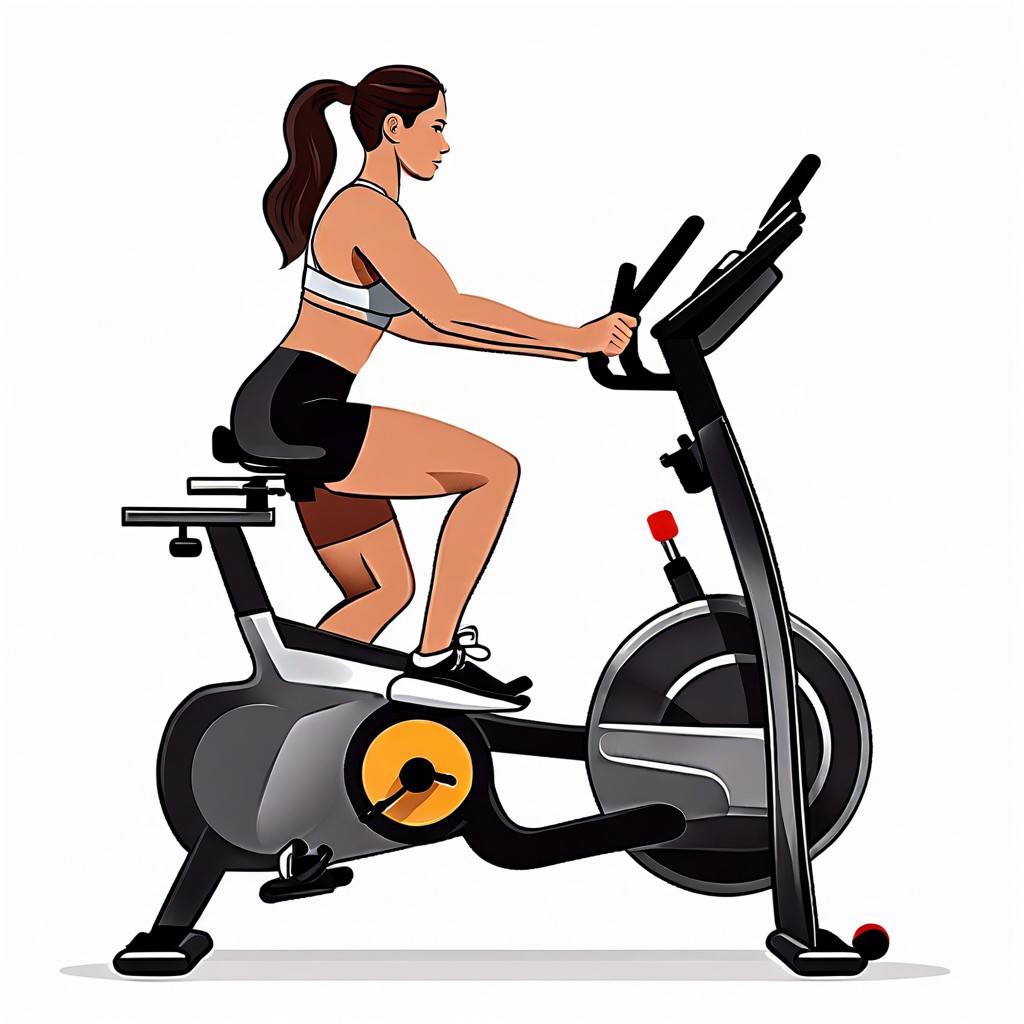Discover the key muscle groups engaged when using a stationary bike, providing both aerobic benefits and targeted muscular conditioning.
Key takeaways:
- Quadriceps are primary muscles worked on a stationary bike.
- Glutes engage when pedaling with force or standing up.
- Core muscles provide stability and support during the ride.
- Proper form and seat adjustment activate the glutes effectively.
- Hamstrings are engaged when pulling up, especially with clip-on pedals.
Muscles Worked On a Stationary Bike

Engaging in a workout on a stationary bike primarily targets the lower body muscles. The quadriceps are at the forefront, contracting to extend the knee as you push down on the pedals. Complementing the quads, the hamstrings work as you draw the pedal back up, facilitating the bending of the knee.
The gluteal muscles are also activated, especially when you pedal with force or stand up in the saddle on a spin bike. This action mimics climbing a hill, leading to a more pronounced engagement of the glutes. The calves, specifically the gastrocnemius and soleus muscles, come into play as you point your toes to push the pedals.
Beyond the legs, the core muscles, including the abdominals and lower back, engage to provide stability and support throughout your ride. This ensures a balanced distribution of power to the legs and protects the spine. Riding a stationary bike also strengthens the heart muscle; consistent cycling improves cardiovascular endurance, making the heart more efficient at pumping blood.
Quads
The quadriceps, or quads, are a group of four muscles located at the front of the thigh. They are primary drivers in the pedaling motion on a stationary bike. When you push down on the pedals, your quads contract, and this repetitive action over time can lead to significant strengthening and toning of these muscles.
To maximize quad engagement, focus on the downstroke of your pedaling and maintain constant resistance. This will ensure that your quads work hard throughout your cycling session. Integrating hill simulations or increasing resistance settings can further challenge your quads, leading to greater endurance and muscle definition.
As you cycle, maintaining proper form is crucial. Position your feet flat against the pedals and align your knees with your toes to prevent strain. Keeping a steady pace, rather than speeding up and losing form, will keep the tension on your quads and promote effective muscle conditioning. Regular workouts on a stationary bike can result in stronger, more defined quadriceps as part of an overall lower-body fitness regimen.
Glutes
Engaging the glutes effectively on a stationary bike requires proper form and seat adjustment. With your feet firmly planted on the pedals, you should focus on pushing down through the heels during each stroke. This deliberate action helps activate the gluteal muscles throughout the pedal cycle.
To further target the glutes, position the seat at a height where your leg is almost fully extended at the bottom of the pedal stroke. Too low a seat position can lead to quad dominance and reduce glute engagement.
Incorporating hill or high-resistance intervals into your workout can intensify muscle activation. As you encounter increased resistance, your glutes work harder to maintain the pedal cadence, promoting strength and endurance gains.
Remember, consistent pedaling speed and resistance challenge the glutes to sustain effort, leading to muscle development and toning. Balancing the workload between the front and back of the leg ensures a comprehensive lower body workout.
Hamstrings
Engaging the hamstrings effectively during stationary bike workouts is key for balanced leg muscle development. These muscles, located at the back of the thighs, play a crucial role in the pedaling motion. As you push down on the pedals, the hamstrings work in concert with the quadriceps, but they truly get activated when pulling up if using bike shoes that clip onto the pedals.
Proper positioning is essential to ensure your hamstrings are targeted. Ensure the seat height is adjusted so that your leg is about 90% extended at the lowest point in the pedal stroke. This prevents overextending the knee, which can lead to reduced hamstring engagement.
Incorporating hill climbs or increasing the resistance settings on the bike can also accentuate the workload on the hamstrings. The added tension simulates uphill riding, requiring more forceful pedal strokes that activate the hamstrings more intensely.
For those looking to specifically strengthen their hamstrings, it is advised to complement biking with additional exercises, such as deadlifts or hamstring curls. This balanced approach can enhance overall leg strength and prevent muscle imbalances.
Calves
Engaging the calves during a stationary bike workout is inevitable as they play a pivotal role in the pedaling action. As you push down on the pedals, the gastrocnemius and soleus muscles — the two primary muscles in the calves — contract to provide the necessary force. This action is most pronounced during the downstroke of each pedal cycle, where the plantar flexion of the foot activates the muscle fibers.
To target these muscles effectively, it’s essential to maintain proper foot placement on the pedals. Positioning the balls of your feet over the pedal spindle can enhance calf engagement. Additionally, varying your workouts by standing up in the saddle or increasing the incline can intensify the workload on your calf muscles, contributing to better strength and definition over time.
Stretching is equally important to prevent tightness and improve flexibility in the calves. Incorporating calf stretches before and after cycling can aid in muscle recovery and performance. With consistent training on a stationary bike, your calves can become stronger and more toned, aiding in daily activities that require walking, running, or jumping.
Related
- What Muscles Does Cycling Work: A Handy Guide
- Benefits of Stationary Bike: Improving Your Health and Fitness at Home
- Stationary Bike Calories Burned: Calculate Your Workout Benefits
- Calories Burned Biking: Factors, Calculations & Tips for Efficiency
- Benefits of Cycling: How It Enhances Health and Well-being